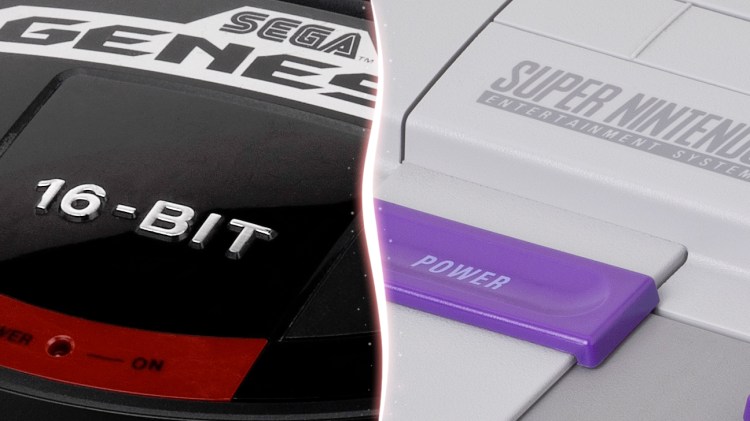You were either with Super Nintendo or with Sega Genesis. No middle ground existed (although the PC gaming was still carrying on strong).
All respect to the Turbo Grafx-16 (and no respect to the CD-i), but the fourth generation of home video game consoles was a two-horse race. The Big N followed up the Nintendo Entertainment System, the machine that revived the industry following the infamous crash of 1983, by adding the word “Super” to everything, and Sega rose from Master System-based desolation with the appropriately named Genesis. A rivalry between the two machines in the West — particularly the United States — created a direct competition series of ad campaigns that would define a generation of child gamers through tribalism and exclusives. And as much as adults bought the systems then and still argue over them now, the Console War as we knew it was most certainly a marketing push that skewed young.
People can easily still find lingering traces of what the Super Nintendo Entertainment System and the Sega Mega Drive/Genesis wrought in today’s gaming landscape. What became known as the Console War is both a relic of its time and a more direct foretelling of what would become the future of a lot advertising psychology. In honor of the Super Nintendo’s 25th anniversary this past Saturday, let’s take a look back at the battle that defined the system, it’s rival, and a gaming’s most revolutionary generation.
Mutually assured demographics
Sega struck the first blow, with its newly formed Sega of America staff using the year head start the Genesis had in the US before the SNES’ arrival to come up with the slogan that would embolden game marketing for almost a decade: Genesis does what Nintendon’t. In order to get its tubular, too-cool-to-handle vibe to the masses, Sega would advertise aesthetic over technical specs. Announcers rattled off the system’s number of bits and colors (which was a thing) and blast-processing feature (which was not actually a thing) in authoritative, easy to digest — and repeat — talking points.
The games themselves barely factored into the commercials. Kids would pick up the system, and playing it would overwhelm them, with the game screen portrayed titled cameras or projected on distorted surfaces. Smoke and wind machines were also a common background occurrence. All of this emphasized a confrontational, “Can you handle it?” attitude.
And power was the key to Nintendo’s successful competition. The Big N had industry clout to burn, and began the Console War piggy-backing on what had worked before, namely expanding its “Now You’re Playing with Power” campaign by adding the phrase “Super Power” to the end.
But Nintendo eventually countered Sega’s in ads, and the fight was in full swing.
Nintendo and Sega began releasing competing commercials that directly compared and debated their rival’s merits, flexing their processing specifications and exclusive game titles in an ever-escalating bout of numbers and bragging rights. Their mutual calling-out of each other eventually went beyond the systems themselves, beginning a second Console War offensive on the hardware peripheral front. It was ridiculous, loud, and unforgivably ’90s. And it worked.
Buying in for good
At $200 for the SNES and $190 for the Genesis, these consoles turned birthdays and Christmases into single-gift occasions for kids (this writer included). Tack on the eventual hardware/game peripherals, and even most middle-income families stuck with one platform for the console generation. And with most exclusive titles staying exclusive — or at least until a few decades later — this was not a decision taken lightly. This, for many American schoolkids, was the first practical lesson in making an investment. Hell, for most of us, this was our first real commitment in life.
But give some credit to marketers. Both Nintendo and Sega expanded their brands in both awareness, scope, and design over the Console War to create and take advantage of the tribalism being sowed. Again, like Coke and Pepsi, Nintendo defined itself by the red of their mascot’s hat just as much as Sega made itself known by the blue of their mascot’s spikes. The calming gray (with purple affectations) of the SNES stood in marked contrast to the black gleam of the Genesis. Nintendo was family-friendly, and Sega was edgy. Super Nintendo versions of games had better graphics, but the Genesis versions had blood.
It took a former Nintendo partner to bring about a new front, and ultimately an end, to the console war during the very next hardware generation.
This is how the Console War died
While each successive hardware generation is desperately dubbed a Console War in the hopes of audience attention and comment numbers, the SNES-Genesis race ended when Sony devastated the former “Big Two” companies in the fifth hardware generation. With Sony being another major force in the same space, there were now just too many parties for direct, competitive advertising.
Sony, Nintendo, and Sega did try and continue with some commercial in-fighting, most noticeably a captured Nintendo winning over a hapless Sony and Sega with the power of Star Fox 64. But no one can have more than one true nemesis, and with three foes on the field, the melee between then can be too much to look at. Combative advertising campaigns with these many adversaries were and are difficult to properly contextualize within the time-span of a television spot. A multifront offensive is much harder to package in an ad campaign than a binary duel between two, distinct foes.




